Quick Look
Grade Level: 8 (7-9)
Time Required: 30 minutes
Lesson Dependency: None
Subject Areas: Physical Science
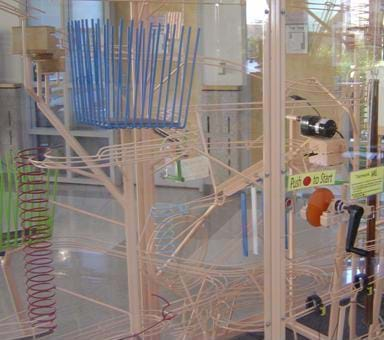
Summary
Simple and compound machines are designed to make work easier. When we encounter a machine that does not fit this understanding, the so-called machine seems absurd. Through the cartoons of Rube Goldberg, students are engaged in critical thinking about the way his inventions make simple tasks even harder to complete. As the final lesson in the simple machines unit, the study of Rube Goldberg machines can help students evaluate the importance and usefulness of the many machines in the world around them.Engineering Connection
One engineering objective is to help people via technological advances. Many of these greater advances in technology can be seen in machines invented by engineers. Rube Goldberg went to school to be an engineer, and after graduating, he decided to become an artist. He drew cartoons of inventions that did simple things in very complicated ways. His inventions involved many complex systems of simple machines, all organized in logical sequences, to accomplish simple tasks. An important skill for engineers is to evaluate the design of machines for their genuine usefulness for their audiences. Often, the best design is the simplest design.
Learning Objectives
After this lesson, students should be able to:
- Explain why some engineered machines have an unquestionable benefit to people and society and others do not.
- Form a critical opinion about the importance of the everyday machines they encounter.
- Explain that mechanical advantage is not always the best way to measure the value of a machine.
Educational Standards
Each TeachEngineering lesson or activity is correlated to one or more K-12 science,
technology, engineering or math (STEM) educational standards.
All 100,000+ K-12 STEM standards covered in TeachEngineering are collected, maintained and packaged by the Achievement Standards Network (ASN),
a project of D2L (www.achievementstandards.org).
In the ASN, standards are hierarchically structured: first by source; e.g., by state; within source by type; e.g., science or mathematics;
within type by subtype, then by grade, etc.
Each TeachEngineering lesson or activity is correlated to one or more K-12 science, technology, engineering or math (STEM) educational standards.
All 100,000+ K-12 STEM standards covered in TeachEngineering are collected, maintained and packaged by the Achievement Standards Network (ASN), a project of D2L (www.achievementstandards.org).
In the ASN, standards are hierarchically structured: first by source; e.g., by state; within source by type; e.g., science or mathematics; within type by subtype, then by grade, etc.
NGSS: Next Generation Science Standards - Science
-
Systems may interact with other systems; they may have sub-systems and be a part of larger complex systems.
(Grades 6 - 8)
More Details
Do you agree with this alignment?
-
Structures can be designed to serve particular functions.
(Grades 6 - 8)
More Details
Do you agree with this alignment?
-
The uses of technologies and any limitations on their use are driven by individual or societal needs, desires, and values; by the findings of scientific research; and by differences in such factors as climate, natural resources, and economic conditions.
(Grades 6 - 8)
More Details
Do you agree with this alignment?
-
Construct an explanation that includes qualitative or quantitative relationships between variables that predict phenomena.
(Grades 6 - 8)
More Details
Do you agree with this alignment?
International Technology and Engineering Educators Association - Technology
-
Develop innovative products and systems that solve problems and extend capabilities based on individual or collective needs and wants.
(Grades
6 -
8)
More Details
Do you agree with this alignment?
-
Analyze how an invention or innovation was influenced by its historical context.
(Grades
6 -
8)
More Details
Do you agree with this alignment?
State Standards
Colorado - Science
-
Use mathematical expressions to describe the movement of an object
(Grade
8)
More Details
Do you agree with this alignment?
Worksheets and Attachments
Visit [www.teachengineering.org/lessons/view/cub_simp_machines_lesson05] to print or download.Pre-Req Knowledge
In order to understand compound machines, it is helpful if students are familiar with the six individual simple machines and their abilities to make work easier, as described in lessons 1-3 of this unit.
Introduction/Motivation
(Using an overhead or LCD projector, display Figure 1, which can be found in the Attachments section.]
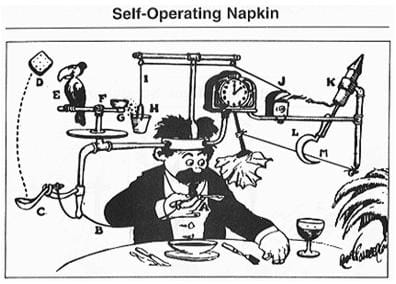
Let's look at this Rube Goldberg cartoon, the "Self-Operating Napkin." When an engineer designs a machine, they are concerned with how it will fit in with the owner's life or what positive meaning it will have for him. Most often, a machine must be practical in order for it to be used. What's the meaning of the self-operating napkin machine? Let's read through the step-by-step description so we can understand it better.
[As a class, read the description: As you raise a spoon of soup (A) to your mouth, it pulls a string (B), thereby jerking a ladle (C), which throws a cracker (D) past a parrot (E). The parrot jumps after the cracker, and the perch (F) tilts, upsetting seeds (G) into a pail (H). The extra weight in the pail pulls a cord (I), which opens and lights an automatic cigar lighter (J), setting off a sky-rocket (K), which causes a sickle (L) to cut string (M), causing a pendulum with an attached napkin to swing back and forth, wiping off your chin.]
Obviously, the machine is complicated. Would you have been able to decipher all of the steps without the description just by looking at the machine? The simple machines (the ladle, parrot, cigar lighter, etc.) interact with one another in a way that is not immediately apparent, and the end function of the machine is not obvious either. Until we understand what the machine does, this compound machine remains fairly meaningless—that is, it is really just a funny hat atop a man's head.
After we have read the description of the "Self-Operating Napkin," it seems that all the steps fit together, similar to all the different motions within a bicycle, where one simple machine interacts with another to contribute to some end function. Considering that a bicycle takes us from one point to another, which is quite useful, why wouldn't people find this napkin-machine useful? (Answers will vary. Although the self-operating napkin might make work easier for us by definition, it probably takes more work to merely hold the machine on your head!)
(Next, look at the "Self-Opening Umbrella" cartoon, Figure 2.)
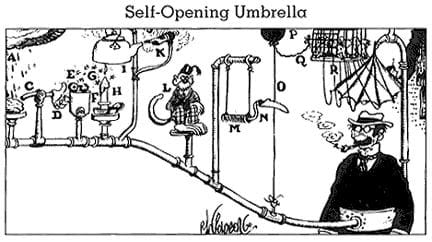
Do these cartoons remind you of machines or devices in your life? Maybe it reminds you of the new electronically powered transportation device that is supposed to whisk you around a city as you stand or an old camping tent that fits together in a way that still takes forever to figure out. It is easy to see why you would be reminded of these things by the Rube Goldberg cartoons; his images depict machines that do jobs always in the most complicated ways. Can you think of other machines that you have seen that do not have much useful meaning? (Let students think about this a moment and listen to their answers. Possible answers: Electric eraser, towel warmer, electric can opener.)
Who remembers the concept of mechanical advantage? Mechanical advantage is a mathematical expression for how much easier a machine makes work. How do we find the mechanical advantage of a compound machine? Do we simply add the mechanical advantages of each simple machine? No, we multiply the separate mechanical advantages. Engineers use the product of the values of mechanical advantage to explain why a compound machine is many times more useful than a single simple machine. Would these Rube Goldberg inventions have a small or large mechanical advantage? (Answer: Probably large, since they involve so many simple machines.) Why are they not realistic for the user? (The machines may be too complex, clunky and weigh a lot to be really useful.) Why is mechanical advantage not always the best way to measure the value of machines? (In these examples, the added complexity outweighs the benefits of the machine. A person would have to exert more effort to use the machine than is needed just to perform the simple task without the machine.)
Engineers must have clear ideas about how their machines will benefit people; otherwise, they are unlikely to be used. As suggested by the Rube Goldberg cartoons, which seem to exaggerate bad designs, engineers should aim to design machines that fit in well with a person's activities and therefore somehow improve that person's life. In general, the simplest designs are the best. Even in complex machines, the simpler the individual components, the easier it is to make the machine, and the more reliable it is. Following the lesson, students are encouraged to use their knowledge of simple and compound machines to conduct the associated activity Design and Build a Rube Goldberg.
Lesson Background and Concepts for Teachers
Professional engineers aim to do good things for society. Compound machines springing from creative engineering have played an intimate role in people's activities for thousands of years, and since our industrial revolution, this country has seen an explosion in complex machines. Many examples of sophisticated machinery that extend beyond usefulness have opened up during this modern era. Rube Goldberg's (see Figure 3) satirical scope magnifies for us the meaninglessness of some of the machines in our society that have gone far beyond what is useful.
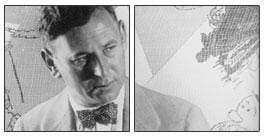
Machines—which, by definition, are useful, but fail to live up to this standard—are seen as an absurdity in our society. Usually, machines that do not serve important purposes are short-lived. Rube Goldberg noticed that ironically these absurd machines were sticking around. Perhaps it was the public's fascination with new, exciting inventions that enabled these machines to linger. Or, perhaps people were effectively convinced by salespeople that this machine was necessary in their lives. Rube Goldberg desired to document this modern phenomenon and won lasting fame—including a dictionary entry—or his images.
Rube Goldberg's cartoons reach to such great heights of exaggeration that we are tempted to look for meaning: From where do machines in our society grow? Designers and the public alike can see that machines are rooted in serving some real purpose for people. The engineering design of machines must be characterized by a striving for this particular kind of meaning; otherwise, the machine is doomed to an existence as a funny hat or a hunk of material.
Associated Activities
- Design and Build a Rube Goldberg - Students use their knowledge of simple and compound machines to create Rube Goldberg contraptions that perform tasks in overly complex ways.
Lesson Closure
What is an example of a machine in your life that has positive, useful meaning? (Possible answers: A bicycle, because it fun to ride and it can get you to school; a blender, because you can make delicious smoothies with it; video games, because you look forward to playing them; etc. List the suggested machines on the board.) Do you think many people have these machines and enjoy them like you do? (Expect the general answer to be yes.)
What are some machines that remind you of Rube Goldbergs? (Possible answers: Shoes with blinking lights – the light is useless and annoying; an electric can-opener, because it is not that much easier than using a manual can-opener; a leaf blower, because it hardly picks up or moves many leaves compared to a simple rake, especially when considering its annoying noise and air pollution; etc. List suggested machines on the board.)
The mechanical advantage of simple machines is a numerical representation of how a simple machine makes work easier by using the machine. In a compound machine, the mechanical advantages of its individual components are not added together but multiplied, resulting in a much larger advantage to using multiple simple machines together. In the Rube Goldberg contraptions, the mechanical advantage is large, however; the machines make it overly complicated to do simple tasks. Remember, these Rube Goldberg designs are intended to make fun of super complex machines. In reality, engineers must understand their audiences in order to design machines that fit in well with people's lifestyles and improve their lives.
Vocabulary/Definitions
compound machine: A machine that consists of two or more simple machines and allows for work to be done easier.
mechanical advantage: The number of times a force exerted on a machine is multiplied by the machine.
Rube Goldberg: Cartoonist and engineer who poked fun at overly complicated machines; a machine that operates in a complicated way in which the procedure could have been much simpler.
simple machine: The fundamental parts of any machine. Simple machines can exist on their own and are also sometimes hidden in the mechanical devices around you; a device that performs work by increasing or changing the direction of force, making work easier for people to do.
Assessment
Pre-Lesson Assessment
Concept Verification: Solicit, integrate and summarize student responses. Ask the students:
- How many simple machines are contained in the Self-Operating Napkin? (The answer is arguable, but a solid answer is 6: the ladle, parrot, perch, lighter, sky-rocket/sickle and pendulum.)
- If each simple machine had a mechanical advantage of 2, what is the mechanical advantage of the compound machine? (Answer: It has 6 simple machines, each with a mechanical advantage of 2, so the total mechanical advantage is 12.)
Post-Introduction Assessment
Encourage Critical Thinking Skills: Lead students in a discussion about the fact that the mechanical advantage of the Self-Operating Napkin is quite high. Ask them:
- Why is this so? (Answer: Due to the higher number of simple machines together in the compound machine.)
- Is mechanical advantage a good way to measure this particular machine's value? (Let students talk it over with a neighbor for a minute, and then ask them to share their thoughts.)
Lesson Summary Assessment
Round Robin Rube: Ask students to think of a simple task that would make a good Rube Goldberg idea, and raise their hands (or indicate thumbs up) when they have an example. (Possible answers: Tying your shoe, raising your hand in class, getting your mail from the mailbox, etc.). Make a list on the board. In small teams or as a class, choose one of the ideas and have one person start the Rube Goldberg design on a piece of paper (or on the classroom board) with one simple machine. Have the next student add another simple machine or "step" to the design, until everyone has had a chance to add to the design. How crazy can we get?
Discussion Questions: Solicit, integrate and summarize student responses. Ask the students:
- What are some complex machines that you have encountered in your lives? (Write the responses on the board. Have a discussion about the importance of these machines.) Do these machines make work easier or harder? How useful are they?
- (Have a discussion about mechanical advantage.) Is mechanical advantage always the best way to measure the value of a machine? Why or why not?
Lesson Extension Activities
Have students research inventions that are considered to be Rube Goldberg in nature.
Subscribe
Get the inside scoop on all things TeachEngineering such as new site features, curriculum updates, video releases, and more by signing up for our newsletter!More Curriculum Like This

Students expand upon their understanding of simple machines with an introduction to compound machines. This lesson encourages students to critically think about machine inventions and their role in our lives.

Students analyze a cartoon of a Rube Goldberg machine and a Python programming language script to practice engineering analysis. In both cases, they study the examples to determine how the different systems operate and the function of each component.

Students research and learn about simple machines and other mechanisms through learning about a Rube Goldberg machine. Student teams design and build their own Rube Goldberg devices that incorporate at least six simple machines. This project is open-ended with much potential for creativity and fun.
References
http://www.rube-goldberg.com/
Copyright
© 2007 by Regents of the University of Colorado.Contributors
Michael Bendewald; Malinda Schaefer Zarske; Janet YowellSupporting Program
Integrated Teaching and Learning Program, College of Engineering, University of Colorado BoulderAcknowledgements
This digital library content was developed by the Integrated Teaching and Learning Program under National Science Foundation GK-12 grant no. 0338326. However, these contents do not necessarily represent the policies of the National Science Foundation, and you should not assume endorsement by the federal government.
Last modified: December 14, 2020







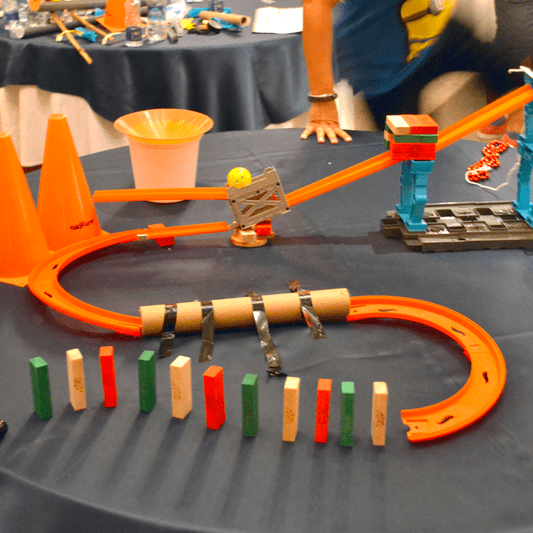
User Comments & Tips